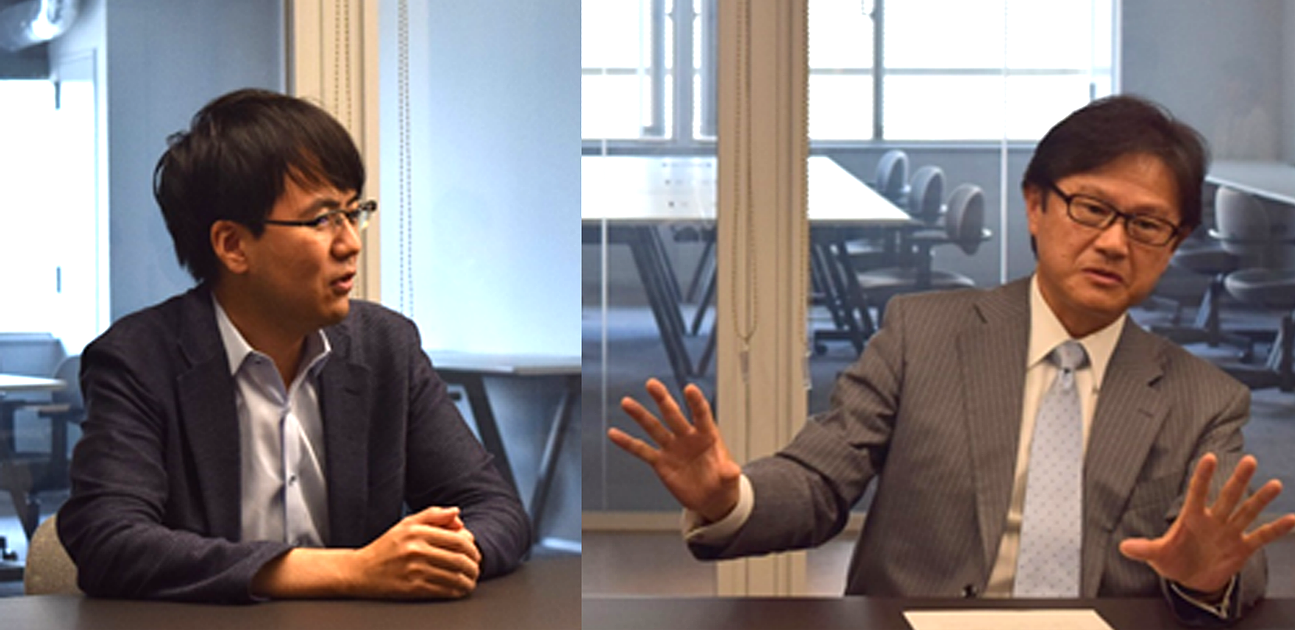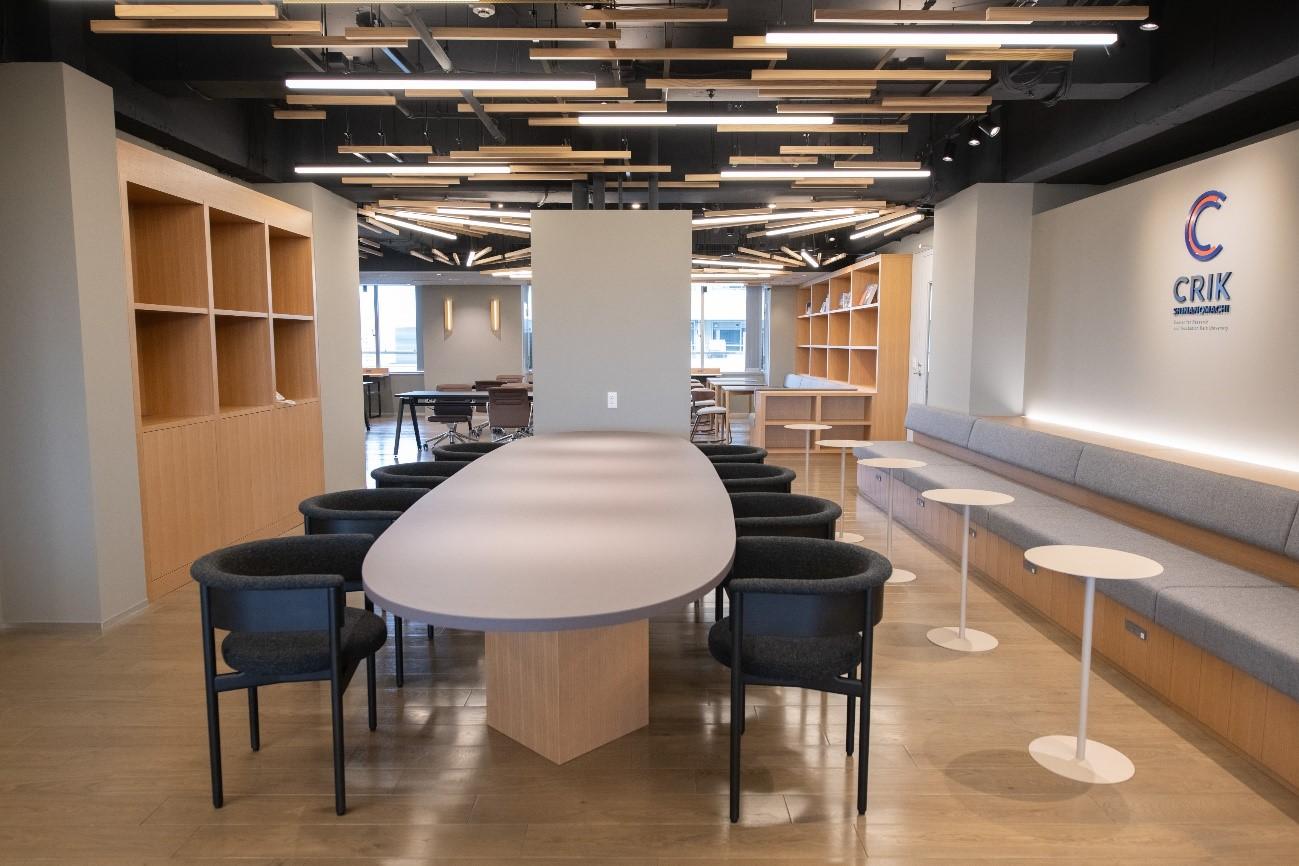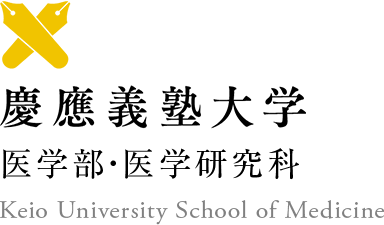- Home
- Features Index
-
Features
Features
CRIK Shinanomachi: A Hub of Innovation Transforming the Future of Medicine and the World
2025/04/17
In May 2024, the Center for Research and Incubation, Keio University (hereafter “CRIK Shinanomachi”) opened on the ninth floor of Building 2, which is shared by the Keio University School of Medicine and Keio University Hospital. CRIK Shinanomachi was established as a platform for supporting entrepreneurship and collaborative research across a wide range of fields, including medicine and healthcare.
Here, we speak with Masaya Nakamura, a professor in the Department of Orthopedic Surgery and a vice dean of the Keio University School of Medicine (in charge of industry-academia collaboration and innovation), along with Yuki Tazawa, Project Lecturer at the Center for the Promotion of Interdisciplinary Research in Medicine and Life Science (PIRMS). As central figures in the establishment and operation of CRIK Shinanomachi, they shared their goals for supporting entrepreneurship and their vision for the center.

Driving Innovation and Supporting Startups
Q: To begin, could you share your roles and the projects you are working on?
Nakamura: As a vice dean, I am responsible for promoting industry-academia collaboration and innovation within the School of Medicine. I am also a member of Keio’s Office of Innovation and Entrepreneurship, where I am involved in fostering innovation across the university, which includes supporting startups. Managing CRIK Shinanomachi is part of these broader efforts.
Tazawa: I currently work under Dr. Nakamura on entrepreneurship support, but prior to that, I was involved in launching the Keio Healthcare Venture Contest in 2016. It was the first business contest organized by a medical school in Japan, and I believe it remains a unique initiative to this day. Although I have since handed over the reins to younger colleagues, my involvement in supporting entrepreneurship began there.
Additionally, I am engaged in initiatives such as the COI-NEXT Program on Open Innovation Platform for Industry-Academia Co-Creation, led by Prof. Nakamura, and the Hills Joint Research Laboratory for Future Preventive Medicine and Wellness, which was launched in collaboration with Mori Building Co., Ltd. and the Center for Preventive Medicine at Azabudai Hills. These efforts all contribute to promoting innovation and supporting entrepreneurship.
――Why Is the School of Medicine Supporting Startups?
Q: What is the rationale for Keio University, especially its School of Medicine, in providing support to startups?
Nakamura: One reason is that supporting startups aligns with the founding spirit of Keio University. Our founder, Yukichi Fukuzawa, advocated for making Keio a leader of society.
Additionally, the mission espoused by our current president, Kohei Itoh, is to evolve into “a research university that forges the common sense of the future paradigm.” This mission is intrinsically connected to the concept of startups, as they innovate and create new societal norms.
Another key factor is the evolving mission of universities. Traditionally universities were expected to have two functions: research and education. However, the 2015 amendment to the School Education Act introduced a new requirement: universities are now expected to contribute to societal development by widely disseminating the outcomes of their research.
At Keio, we have produced numerous outstanding research achievements and publications, but we now recognize that it is not enough to simply conduct research. We must also ensure that we translate the outcomes of our research into tangible applications, thereby making meaningful contributions to the public good.
Supporting startups represents the first step in achieving this goal.
Q: What specific framework is in place to support startups?
Nakamura: In 2018, we established the Office of Innovation and Entrepreneurship, and in 2021, we further strengthened the structure by creating a dedicated startup division within the headquarters. Initiatives such as launching the Keio EIR (Entrepreneur in Residence) model, implementing a system for Keio University-developed startups, and conducting the Keio Startup Incubation Program (KSIP) have all been part of these efforts. CRIK Shinanomachi was opened as an extension of this progression.
Tazawa: As of August 2024, Keio University has produced 291 startups, ranking second nationwide (based on the Ministry of Economy, Trade, and Industry’s 2023 survey on university-developed ventures). Many of these startups emerged from initiatives like the Keio Healthcare Venture Contest.
――The Significance Behind Supporting Startups
Q: What impact does supporting startups have on students?
Tazawa: Supporting startups goes hand in hand with fostering entrepreneurship. I believe that entrepreneurship skills can be valuable even if you never end up starting your own business. There is also the concept of intrapreneurship, which involves addressing various challenges that arise in the day-to-day operations of large, established organizations such as hospitals and corporations. An independent mindset of solving problems through innovative ideas is precisely what defines entrepreneurship. Even if someone tries their hand at starting a business and fails, that experience will undoubtedly serve as a valuable asset in shaping their future career.
For medical professionals in clinical practice, failure is not an option. However, in the context of entrepreneurship, trial and error are encouraged. Students who have learned from the failures and successes of startups will bring that invaluable experience into the medical field, ultimately advancing the future of medicine.

Entrepreneurship Is Merely the “How.” What Matters Is the “What” and “Why.”
Q: Some students may discover they are more suited for business than medicine. What are your thoughts on this?
Nakamura: I believe there are many such students. However, entrepreneurship is merely the “how”—a means to an end—not the goal itself. The most important questions are: what do you hope to achieve and why? For students who view entrepreneurship as something glamorous or a way to make money, it’s crucial to clarify that those motivations alone are insufficient.
Tazawa: The right approach is to first have a groundbreaking idea—one that could save patients’ lives or transform society—and then choose entrepreneurship as the means to bring it to life. Students who won the business contest and started their ventures all shared excitement for their ideas and a strong determination to turn them into reality to benefit the world.
――The Importance of Building a Research Ecosystem
Q: What benefits do you expect from supporting startups?
Nakamura: In the past, we often failed to fully capitalize on our early-stage research. For example, if we can leverage research findings by filing patents or licensing technologies, we can implement these results in society, contributing to the public good while also generating revenue for the university.
Historically, universities and university hospitals have avoided discussions around profit, but even in the academic world, generating revenue through societal contributions is critical for establishing a sustainable research ecosystem.
Tazawa: If research outcomes generate profit, that profit can then be used to enhance the research environment and improve education, which in turn helps nurture talent, create new early-stage research ideas, and ultimately raises the quality of research. This is the essence of a sustainable research ecosystem. Financial resources are indispensable for creating such a system.
Keio, like Japan’s medical community as a whole, is unaccustomed to the idea of generating profits or raising funds from private companies. However, there will likely be an increasing need for universities to shift toward revenue-generating models moving forward.
――The Three Keys to a Research Ecosystem: Viable Ideas, People, and Places
Nakamura: When building a research ecosystem, viable research ideas are, of course, essential, but they alone are not enough. People and places are equally important.
CRIK Shinanomachi is exactly the kind of place where people can meet and connect. When you come to CRIK Shinanomachi, you can build connections with researchers, entrepreneurs, venture capitalists (VCs), and any number of people ready to help you succeed. Having such a place expands networks and facilitates the circulation of funding. This is one of the primary objectives of CRIK Shinanomachi. Among its members, CRIK Shinanomachi includes the Keio Innovation Initiative, a Keio-affiliated company managing a venture capital fund worth 35 billion yen. Additionally, the facility is staffed with incubation managers and science liaisons who promote communication between faculty, researchers, and CRIK members. They are also available to provide support for a wide range of inquiries from members and visitors.
Q: Is support limited to faculty and students at the Keio University School of Medicine?
Nakamura: No, the use of CRIK Shinanomachi is not restricted to the School of Medicine. We aim to create an open innovation space where students from other faculties, students from other universities, and members of private companies can gather and collaborate.

Aiming to Become a Collaborative Hub for Diverse Stakeholders
Q: What is your vision of success for CRIK Shinanomachi?
Nakamura: There are different levels of success to consider: success for CRIK Shinanomachi itself, success for Keio University, and success for Japan as a whole.
For CRIK Shinanomachi, success means becoming a place where diverse stakeholders gather, leading to the emergence of various seed projects, business models, and startups. A place where large-scale collaborative research projects can take shape. Some of these startups may find real-world applications for their research, achieve public listings, or even grow into unicorn companies. We want this kind of thing to become part of daily life here.
These developments will help CRIK Shinanomachi earn a reputation as a place where people can connect and where exciting things happen. Being part of CRIK Shinanomachi would become a status symbol, and the center itself would serve as a hub that brings people together. That is our vision of success for CRIK Shinanomachi.
As a result, Keio University will establish itself as a leader in society and become a research university that shapes the common sense of the future paradigm. This is what Keio imagines for its future.
When it comes to the School of Medicine, we aim to drive healthcare reform. We want to transform medicine, caregiving, and healthcare through technology. By contributing to both medicine and society, we aspire to grow and evolve. That is the vision we have in mind for the School of Medicine.
For example, we want to catch up with and even surpass advanced institutions like Stanford, Harvard, and the National University of Singapore. Japan must also produce pioneering academic institutions such as these.
For Japan, success would be addressing the challenges of a super-aging society and establishing itself as a global role model. As the world’s longest-living nation, Japan has the opportunity to tackle these issues ahead of other countries and share its solutions outside Japan.
Tazawa: In the near future, other developed nations will face similar challenges of aging populations and low birth rates. As a pioneer, Japan has the chance to develop innovative solutions using cutting-edge technology and set global standards. If we can achieve this, our country could lead the way in much the same way it did with its automobile industry in the past.
――Designing Spaces for Open Communication
Q: What concepts guided the creation of CRIK Shinanomachi?
Nakamura: We envisioned a space where people could drop by, gain inspiration, and experience a shift in mindset. We spent time carefully discussing the layout, interior design, and even the choice of furniture to achieve this effect.
The key was to create a space where human interaction and communication could spark new ideas.
For this reason, we included open spaces and community areas. All private offices are enclosed with glass walls, allowing for visibility and fostering an environment where relationships can be built more easily.
Tazawa: CRIK Shinanomachi operates on a membership basis and is generally not open to the public. However we plan to expand opportunities for exchange by regularly hosting public events for anyone to join.
These events aim to broaden connections through seminars featuring professionals from diverse fields, such as corporate representatives and researchers from different disciplines, as well as pitch events where students can showcase their ideas.

Reimagining Society at CRIK Shinanomachi
Q: What are your expectations for CRIK Shinanomachi?
Nakamura: For society to change, individuals must change first. When individuals change, organizations change, and when organizations change, society follows. For individuals to change, a shift in mindset is essential. I believe CRIK Shinanomachi can serve as a catalyst for this kind of transformation.
Tazawa: In a system like Japan’s, with its large corporations and well-established public healthcare system, creating a sustainable model from scratch is what entrepreneurship is all about. I think this type of entrepreneurial activity will be increasingly required in the future, and without it, Japan may struggle to sustain itself. Developing this kind of talent within the Keio University School of Medicine is incredibly meaningful, not only for clinical practice but also for research.
――Envisioning a Better Society Through the "Health Commons" Approach
Q: Finally, do you have a message for students, researchers, and business professionals?
Nakamura: I am also the leader of the COI-NEXT project, an initiative to support the creation of collaborative spaces. This project views well-being as a fundamental right for all people and focuses on developing services that support individuals and families coping with concerns and uncertainties after medical treatment or injury, with the ultimate goal of integrating these services into society. By leveraging the "health commons" approach—bringing together the knowledge and technologies of academia and industry and fostering interdisciplinary research—we aim to build a shared-resource health ecosystem where everyone can thrive. This is the "common sense of the future" we are striving to create.
We invite all who share this vision to be part of CRIK Shinanomachi and help transform society—starting here, at the heart of Keio University’s Shinanomachi Campus.
Masaya Nakamura
After graduating from the Keio University School of Medicine in 1987, Prof. Nakamura joined the school’s Department of Orthopedic Surgery. After working as a neuroscience research fellow at Georgetown University in 1998, he returned to Japan in 2000 as an assistant professor in the Department of Orthopedic Surgery at the Keio University School of Medicine. In 2004, he was appointed as a senior assistant professor, and in 2012, he became an associate professor. He has held his current position as a professor since 2015. Beginning in 2017, he served as an associate dean of the Keio University School of Medicine before appointed his current role as a vice dean in 2021. In 2022, Prof. Nakamura was elected as a member of the Science Council of Japan (Section II), became president of the Japan Medical Society of Spinal Cord Lesion, and, starting in 2024, has served as the president of the Japanese Society for Spine Surgery and Related Research.
Yuki Tazawa
Prof. Tazawa graduated from the Keio University School of Medicine in 2014. As a medical student, he founded a medical IT venture, which he later sold. After graduation, he completed his residency and joined the Department of Neuropsychiatry at Keio University School of Medicine. His research focuses on using artificial intelligence (AI) and the Internet of Things (IoT) to develop quantitative diagnostic tools for mental illnesses and their subsequent commercialization. After earning his doctorate, Prof. Tazawa began working concurrently on promoting innovation at Keio University, where he supports large-scale collaborative research projects with companies and fosters the growth of university-developed startups. Outside the university, he operates Mizen Clinic in the Toyosu, Ichigaya, and Ikejiri-Ohashi neighborhoods of Tokyo, offering evening consultations until 10 p.m. to cater to working professionals. He is also active as an occupational physician.
*All affiliations and titles are those at the time of publishing.


